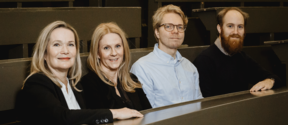See, hear, feel!

Technological development, digitalisation and globalisation are impacting the operating environment of companies in a complex way. It is difficult to precisely predict activities when undergoing constant and fast-paced change. Success in competition requires companies to be agile, and this is why their strategies need to be adjustable as well.
Assistant Professor Timo Vuori of Aalto University is familiar with different ways to prepare and implement strategies. Vuori says the basic idea– maximising benefits and adding value with limited resources relative to the competition – has remained the same starting from strategies for war from 3,000 years ago. Today, companies need to constantly check the assumptions they have made and have the ability to make fresh choices rapidly.
“Recognising what’s relevant from the perspective of decision-making remains central, although the collection of data and measuring things precisely, for example, have become commonplace. Scenario work, constantly creating options as well as measuring and evaluating the correct things with respect to objectives are significant,” he says.
Vuori talks of living strategy, a new kind of way to plan operations. In place of a rigid, set-in-stone model, its core is formed by a live working process in which the implementation, evaluation and renewal of strategy iterate.
Listening aids success
Anticipating the future requires the making of assumptions, and experimentation is a concrete way to explore which path is most probable and what issues should be promoted. Vuori mentions as examples two corporations that develop digital services and emphasise analytics, Google and Amazon, both of which conduct thousands of experiments each year. On the other hand, experiments and prototyping are also familiar from industry and production. How these are viewed is largely tied to management.
“Put simply, you can say there are two types of executives: visionary leaders who trust their own intuition and see no need to test their thinking, and managers who favour experimentation and value continuous learning.”
Perceiving alternative paths and experimenting are important also at Aalto University, where research-derived new ideas for strategy work have already been taken into use. The University’s new strategy, which will come into force in 2021, is being prepared with input from the entire community from students to stakeholders. Engaging and listening to people is beneficial for at least two reasons, Vuori says.
“The quality of thinking improves. There’s a difference when three or three hundred people take part in brainstorming. Listening to a large group provides a broader view of the situation. Coming up with ideas together also helps individuals develop their own thinking and teaches them to understand different alternatives.”
And how do you identify things that shouldn’t be changed?
“Identifying your own strengths is surprisingly difficult. Organisations can even destroy them inadvertently,” says Timo Vuori.
“The danger in overreacting as well as excessive enthusiasm is that too many things get changed. That’s why it’s important to understand and analyse current operating practices and critically compare them to new ways of doing things. The realisation of fresh ideas rarely succeeds completely. You’ll be up against similar practical challenges as in the status quo, and this should be taken into consideration.”
Organisational culture and human emotions are also of significance in the strategy process.
“It’s important to foster an atmosphere of openness so that alternatives and also difficult issues can be talked about. Fortunately, more and more executives have acknowledged the impact psychological factors have. When we understand emotional reactions, they can be managed and harnessed for the implanting of the strategy. How things are said and what the staff feel like are often more meaningful than what is said.”
Bringing together the thinking of different groups
Of central importance to the success of a strategy is that the key stakeholders consider it meaningful. But it is not necessary for every employee to be familiar with the strategy in full.
“It is essential that employees who need to constantly make situation-specific choices in their work to internalise the strategy. But there are many tasks in which it is not necessary to know every detail of it.”
Vuori thinks living strategy suits everyone who needs change. The making of good decisions requires an analytic approach, and living strategy guides the organisation to recognise both fresh opportunities and threats. The model of course also contains challenges.
“Living strategy requires broad-reaching examination in order for a sufficient amount of even improbable alternatives to be uncovered for comparison. At the same time, activities need to be very focused.”
In addition to Aalto University, the practices of living strategy have been applied in Finland by, for example, OP Financial Group, whose President Timo Ritakallio co-authored a book about the topic with Timo Vuori. The book utilised both Ritakallio’s practical experiences and Vuori’s research, which focused on strategy work at Nokia.
Timo Vuori has also worked on the strategies of many other companies and he is closely involved in the strategy process of Aalto. Vuori thinks the process will bring the thinking of the organisation’s different groups together for current use.
“Formal processes, analysis and tools provide structure in which people can develop their thinking and become more open to new alternatives. For its part, scrutinising matters more broadly produces better decisions. Learning together is another positive: it recognises the reality of the moment, its alternatives and likely consequences.”
Elävä strategia – Kyky nähdä, taito tarttua tilaisuuteen, Alma Talent 2018, a book co-authored by Timo Vuori and Timo Ritakallio, was used as background material for this article.
This article is published in the Aalto University Magazine issue 25, October 2019.
Read more news

Meet the new ELLIS Institute PIs: Azade Farshad advances AI for medical applications
Farshad’s research background is in computer vision and generative models.
Nominate your candidate for the 2025 Award for Achievements in Teaching at the School of Engineering
Staff and students of the School of Engineering are invited to nominate candidates for the 2025 Award for Achievements in Teaching.
Stay safe near metro stations
When walking on the streets, it is crucial to stay alert to avoid being scammed.






